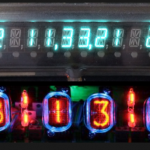
In general for a Vacuum fluorescent display based clock such as Pyrofer’s VFD network time clock , where the build started as a vacuum flourescent display tube he salvaged from an old machine. The VFD was a 16 character, 14 segment display, all controlled via serial input.
The main control board is an Arduino with a WizNet 5100 Ethernet board. The clock connects to the Internet via DHCP so there’s no need to set an IP address. Once connected, the clock sets itself via network time and displays the current date, time, and temperature provided by a Dallas 1-wire temperature probe.
All this is pretty standard for a Nixie clock build, if a little excessive. The maker used the USB support on his PIC to throw a USB port on his board and wrote an awesome bit of software for his PC to set the time, upload new firmware, and set the color fade and speed. With this many LEDs, it’s not something you want in your bedroom with all the lights on full blast, so he implemented a ‘sleep’ mode to turn off most of the lights and all the Nixie tubes.


COMMENTS